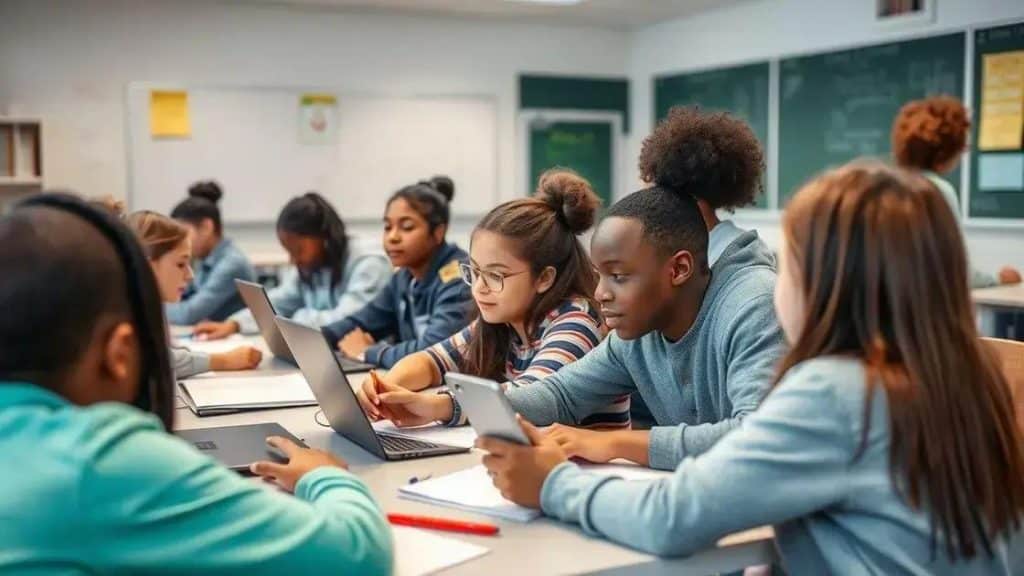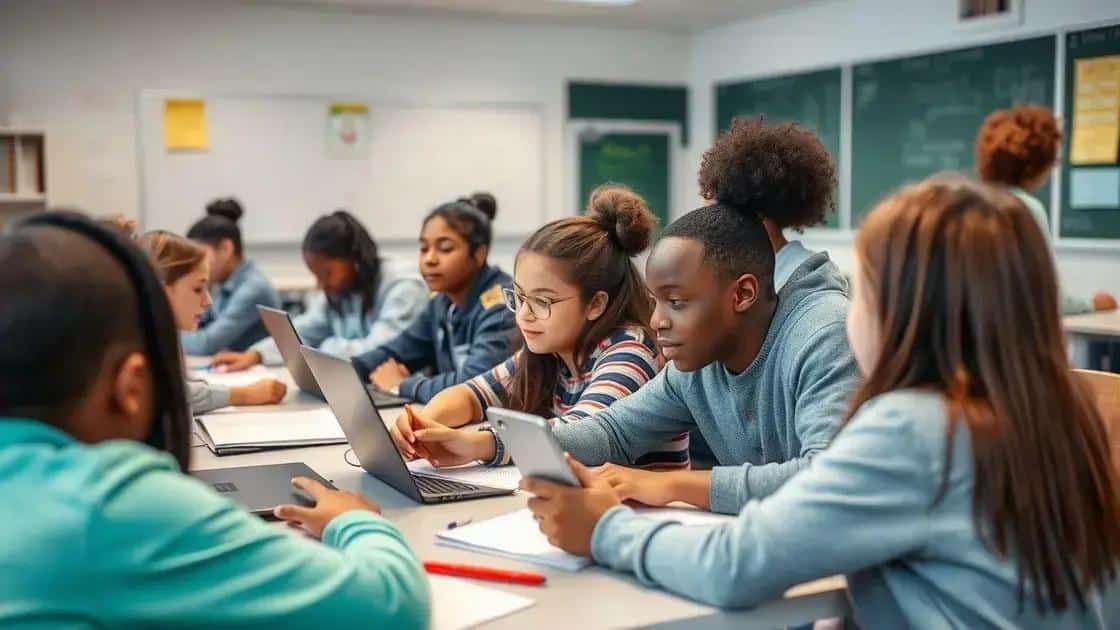Education reform: unlocking potential for future generations

Anúncios
Measuring the impact of education reform initiatives involves utilizing standardized tests, surveys, and data analysis to evaluate effectiveness and improve student outcomes through informed decision-making.
Education reform is at the forefront of discussions about the future of our society. It’s a topic that not only influences policy makers but also each one of us on a personal level. Have you ever wondered how changes in education might affect your children or even your community?
Anúncios
Understanding the need for education reform
Understanding the need for education reform is crucial as it shapes the future of students and society. Every child deserves a quality education, and identifying gaps in the system helps address those needs.
Anúncios
Many factors contribute to the call for change. First, it’s essential to acknowledge that the traditional methods of teaching may not serve all students effectively. Learning styles vary, and a one-size-fits-all approach can leave many behind. By reforming education, we can tailor approaches that meet diverse needs.
Key Issues Driving Reform
Several critical issues highlight the urgency for education reform. These include:
- Outdated curriculum: Many students learn material that isn’t relevant to today’s world, hindering their readiness for future careers.
- Equity gaps: There are significant disparities in educational resources between different socio-economic groups, impacting student outcomes.
- Teacher support: Many teachers face challenges that affect their ability to teach effectively, leading to high turnover rates.
- Technological advancement: As technology evolves, ensuring students are equipped with necessary skills becomes paramount.
As a society, we must recognize that focusing on education reform is about more than policy changes. It’s about giving students the tools they need to succeed. By enhancing teacher training and incorporating technology in classrooms, we can create more engaging learning environments.
Furthermore, engaging parents and communities in the educational process can also drive reform. When families are involved, students often perform better. Therefore, fostering strong relationships between schools and communities is vital.
The need for education reform is not just about fixing problems; it’s about paving the way for a brighter future. We can create a system that nurtures talent, creativity, and critical thinking through collaboration and innovation.
Key challenges in the current education system

The current education system faces several key challenges that hinder its effectiveness. Identifying these issues is crucial for implementing successful education reform.
One major challenge is the lack of adequate funding. Many schools struggle to provide essential resources, such as textbooks, technology, and extracurricular activities. This funding gap leads to inequalities in education quality across different regions.
Teacher Retention and Support
Another significant issue is the retention of qualified teachers. Many educators experience overwhelming stress due to high workloads and insufficient support. This can lead to burnout, forcing talented individuals to leave the profession.
- Low salaries: Many teachers are underpaid, which can discourage highly qualified candidates from entering the field.
- Limited professional development: Opportunities for growth are often scarce, leaving teachers feeling unsupported in their roles.
- Classroom management issues: Teachers may face challenges in managing diverse classrooms without adequate training.
- Increased workloads: Standardized testing and administrative duties can take time away from teaching.
Additionally, the rapid advancement of technology presents both challenges and opportunities in the education system. While technology has the potential to enhance learning experiences, not all schools have equal access to these tools. This digital divide can create disparities in skill development.
The curriculum itself also poses challenges. Many programs remain stagnant and do not reflect current societal needs or student interests. As a result, students may disengage from learning when the material feels irrelevant or outdated.
Finally, many students encounter personal challenges that affect their education. Issues such as poverty, mental health, and family instability can significantly impact academic performance. Addressing these factors is critical for ensuring all students succeed.
Innovative approaches to education reform
Innovative approaches to education reform are essential for creating a more effective and engaging learning environment. As the needs of students evolve, so must the strategies used in classrooms.
One exciting direction is the integration of technology in education. This includes the use of digital tools and resources to facilitate interactive learning. Students often respond well to gamified content, making lessons more enjoyable and effective. By incorporating multimedia, teachers can reach students with different learning styles.
Personalized Learning
Another innovative approach is personalized learning. This method allows students to learn at their own pace, ensuring they grasp the material before moving forward. By leveraging data and analytics, educators can create tailored learning plans that meet individual needs.
- Adaptive learning technologies: These tools adjust based on student performance, providing customized content and practice.
- Competency-based education: Here, students advance upon mastering subjects rather than following a fixed timeline.
- Flexible learning environments: A mix of online and in-person classes can offer students greater control over their education.
Collaboration is also a key element of innovative education reform. Schools can benefit from partnerships with local businesses and community organizations, leading to enriched learning experiences. For example, internships or mentorships can provide students with real-world skills and connections.
Additionally, educators are increasingly recognizing the importance of social and emotional learning (SEL). By focusing on students’ emotional well-being, schools can foster a supportive environment where learners feel safe and valued. Strategies might include mindfulness exercises, conflict resolution training, and emotional regulation techniques.
Incorporating diverse cultural perspectives into the curriculum is another impactful approach. This not only enriches the learning experience but also prepares students for a globalized world. By exposing students to various viewpoints, schools nurture inclusivity and respect for differences.
The role of technology in transforming education

The role of technology in transforming education is significant and increasingly vital. Technology has changed how students learn, making education more accessible and engaging.
One major way technology impacts education is through the use of online learning platforms. These platforms offer students the flexibility to access resources and lessons anytime, anywhere. This means that learners can study at their own pace, taking the time they need to understand the material.
Interactive Learning Tools
Another important aspect is the development of interactive learning tools. Competitions and games encourage student participation and can facilitate deeper understanding of subjects. For example, educational apps can turn math problems or science experiments into fun challenges that motivate students.
- Virtual reality (VR): VR can immerse students in different environments, enhancing their understanding of complex topics like history or science.
- Gamification: Integrating game-like elements into lessons can boost engagement and help solidify knowledge.
- Collaborative tools: Programs like Google Classroom allow students to work together on projects, regardless of distance.
Moreover, data analytics provide educators with valuable insights into student performance. By analyzing this data, teachers can identify strengths and weaknesses in their classes. This allows them to adjust their teaching methods accordingly, giving students the best chance to succeed.
Equally important is the way technology can foster communication and collaboration. With tools like video conferencing, students can connect with peers and experts from around the world. This exposure broadens their perspectives and enhances their learning experience.
As technology continues to advance, its role in education will likely expand. Schools that embrace these changes can create dynamic learning environments that prepare students for a tech-driven future. Ultimately, integrating technology in education not only enhances learning but also promotes essential skills needed for success in the modern world.
Measuring the impact of education reform initiatives
Measuring the impact of education reform initiatives is essential to determine their effectiveness. Understanding what works can help schools implement successful programs that benefit students.
One method to measure impact is through standardized testing. These assessments provide data on student performance before and after reforms are introduced. By comparing scores, educators can gauge improvements in learning outcomes.
Data Collection Techniques
Another technique is gathering qualitative data from students and teachers. Surveys and interviews can provide insights into how reforms affect classroom experiences. Feedback from teachers on changes in teaching methods and student engagement is invaluable.
- Focus groups: Engaging with small groups of students can unveil their perspectives on the changes in curriculum or teaching styles.
- Longitudinal studies: Tracking student progress over several years helps identify long-term benefits or drawbacks of reform initiatives.
- Case studies: Examining specific schools or districts that have undergone reforms can provide detailed insights into what worked and what didn’t.
Moreover, it is vital to analyze trends over time. Collecting data across multiple years allows for a clearer picture of how reforms influence academic performance and overall school climate. Schools can use this information to refine strategies continually.
Collaboration also plays a crucial role in evaluating reform outcomes. By sharing findings with other schools or districts, educators can learn from each other’s experiences and adapt successful practices accordingly. This fosters a culture of continuous improvement within the education system.
Finally, community involvement is essential in assessing reform impact. Engaging parents and local communities can offer additional feedback on how changes affect students’ lives outside school. Their perspectives can highlight areas needing more focus or adjustment.
In summary, measuring the impact of education reform initiatives is crucial for understanding their effectiveness. By utilizing various methods such as standardized testing, surveys, and collaboration, educators can gather valuable insights. This information helps schools refine their strategies and ensure that reforms lead to positive changes. Additionally, involving the community in the evaluation process can provide further context and support for these initiatives. Overall, effective measurement fosters a culture of continuous improvement within the education system. 👩🏫📊
FAQ – Frequently Asked Questions about Measuring the Impact of Education Reform Initiatives
Why is measuring the impact of education reform important?
Measuring the impact helps schools understand what works and what doesn’t, ensuring effective strategies are implemented.
What methods can be used to evaluate the effectiveness of reforms?
Common methods include standardized testing, surveys, interviews, and collecting qualitative data from students and teachers.
How can community involvement enhance the assessment process?
Community involvement provides diverse perspectives and feedback, which can highlight additional areas for improvement.
Why is trend analysis important in education reform?
Trend analysis helps educators see long-term effects of reforms, allowing for adjustments based on data over time.